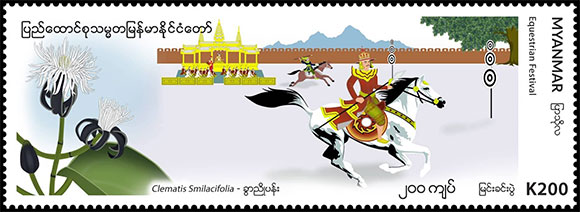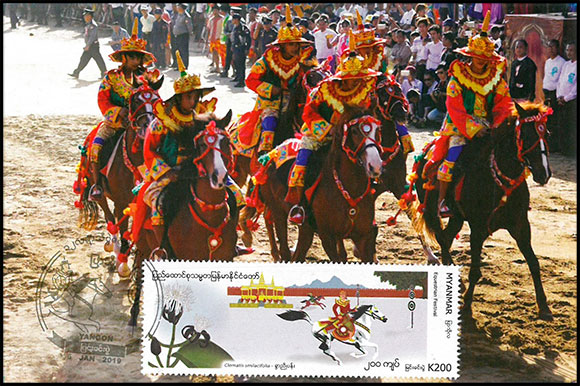
On January 6, 2019, Myanmar Post issued a postage stamp from the Burmese Calendar series dedicated to the month of Pyat Tho.
Throughout their centuries-long history, the Burmese have used various calendar systems. The last time a new calendar system, called the Burmese Era, was introduced was in 639. Therefore, the Burmese Era lags behind the Gregorian by 638 years, and currently, in Burma, not 2019, it is only 1381 years old.
The Burmese calendar is based on a cycle of 19 solar years. Of these, 12 years consist of 12 lunar months, and another 7 years consist of 13 lunar months, with a month lasting either 29 or 30 days. Therefore, a Burmese year has either 354 or 384 days. The Gregorian calendar is also used in Burma, but the traditional calendar takes precedence, especially in everyday life. The Burmese calendar is closely linked to the annual agricultural cycle and to all aspects of traditional Burmese life and knowledge.
In 2019, Myanmar Post planned to issue 12 stamps dedicated to the months of the traditional Burmese calendar: one stamp for each month. The Burmese lunar calendar does not exactly align with our usual months, beginning with the month of Tagu, which falls in March-April. Therefore, the post office began issuing stamps not with the first, but with the tenth month of the Burmese calendar—Pyat Tho, which corresponds to December-January in the Gregorian calendar.
The stamp series was designed by artist Wai Zin Paing: all stamps in the series depict seasonal flowers and one of the traditional festivals that takes place during this month.
Pyat Tho is the month of clematis blooming and the month of military parades.

During the reign of the Burmese kings, the Royal Horse Festival was held annually in the month of Pyat Tho. Colorful military parades and various military competitions lasted the entire month. The four main elements of war—infantry, cavalry, horse-drawn chariots, and war elephants—participated in the festive processions in all their splendor. Competitions were held in the courtyard of the royal palace, demonstrating horsemanship, archery, sword and spear fighting, and much more. The Burmese kings used this festival not only to impress and entertain their subjects but also to select the best, bravest, and most skilled soldiers and officers for their armies.
Military parades in the month of Pyat Tho are mentioned in ancient Burmese manuscripts and songs. The first documented mention of this festival dates back to 674 CE, but some researchers believe the tradition originated significantly earlier.
A postage stamp issued on January 6, 2019, depicts a clematis flower (Clematis smilacifolia) and a horseman wearing traditional armor and holding a spear during the Royal Horse Festival.
This tradition has largely died out, and today Pyat Tho is the month of pagoda festivals. This is a time when everyone makes donations for the repair and maintenance of local temples. The festivals are accompanied by impromptu markets near the pagodas and performances by local musicians and dancers.
Перейти в каталог
I apologize for any errors or inaccuracies


